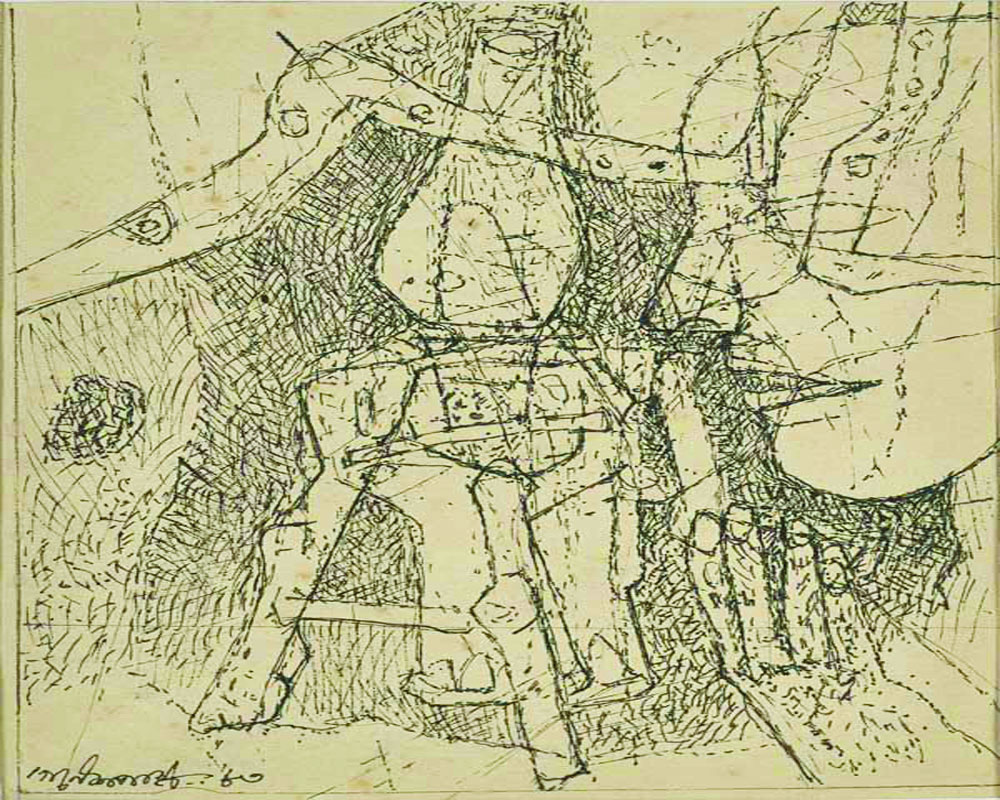Artist Ganesh Pyne’s series of jottings on a graph paper, Looking West, symbolises the constant churning of the mind and its fleeting thoughts, which we fail to gain control over, says Uma Nair
Artist Ganesh Pyne’s jottings in his series of five works, titled, Looking West, make one delve into the intellectual understanding of artistic minds. His works have the power to intrigue. They make us ponder over our million fleeting thoughts. Inscrutable and deeply intricate, these five jottings are a delight to the senses.
The artist’s thoughts about his jottings on a graph paper were aptly recorded by Dolly Narang, founder of the Village Gallery in Delhi, in a show in 1996.
“Anyone who views these jottings is actually in the process of creating a complete dish in an artist’s kitchen. However, just like the difference between the final dish and the burning cooking pot, there is a difference between these jottings and my major works. When a figure starts appearing through the jungle of my scribbled lines, I try to enlarge and develop it repeatedly. These jottings are a pictorial diary of my thoughts. And creating them is my time of pleasure and adventure,” said Pyne to Narang.
The most uncanny canvas
The most uncanny thing about these jottings is Pyne’s preference for his canvas — a plain graph paper. In a show at CIMA Kolkata, he said that these graph paper sheets were printed by Lokenath Agency and used by school children across West Bengal. The execution of his thoughts into a translucent imagery shows not just his affinity with grids but also, how meticulous were his thoughts that unfolded with a rare mathematical precision. One recalls his jottings at CIMA, in which they were punctuated with quotations culled from CG Jung to Paul C’zanne to Rabindranath Tagore, in Bengali and English. Fish baron-turned-Indian collector, Masanari Fukuoka, obviously liked what he saw and was fascinated by the montage of image and text where the artist’s inner self could be explored.
A nest of squiggles
Looking at his jottings is like looking at a labyrinth of cryptic signs that hold within multiple references and reflections. Pyne celebrates an intuitive intensity in his nest of squiggles. In one of the works, we see Washington Irving’s words, “When things get tough, remember, it’s the rubbing that brings out the shine.” Around it are alphabets, cross-hatched lines and forms.
Pyne was a man of few words, a voracious reader and thinker but his idea of rumination was one that was private. He did not believe in the artist being offered up as a public spectacle. Hence, these jottings also draw attention to Pyne’s meticulous moorings in the wish that he wanted them to be a semblance of works-in-progress rather than completed compositions. This decisive stance makes us understand that he wanted to dissolve the distinction between the complete and the incomplete and leave these works open-ended. The scribbles and cross-hatches with lithe lines form an enigmatic symphony.
A hotchpotch of words
Another series of frenzied jottings culminate in a bird that seems to be wounded as its legs are positioned in painful poise. The bird is surrounded by a clutter of inanimate objects, fragile fragments looming over the scene, drawing our attention to the conventions that can be explored in the form of portraiture. Pyne fills his graph paper with words and scratches at random spaces. Intriguing, however, is the way he spaces out the imagery to create a narrative that is never untidy but neat in its jumbled squiggles. He reveals yet conceals the constant churning in his own mind. It’s as if we are looking at a riverbed with the crystal clear water running long after the ripples have settled.
Pyne’s absorption in these jottings unravels his prowess as an illustrator who went into his orbit of deep thoughts. History states that even after he had established himself as an artist, Pyne continued to illustrate the cover of the sharadiya sankhyas of some Bengali magazines, published to mark the commencement of Durga Pujo every year. His obsession with iconographies and elements harks back to this engaging and enduring aspect of his career.
(The works are displayed at the Glenbarra Art Museum, Japan, at sale from September 4 to 5.)


























